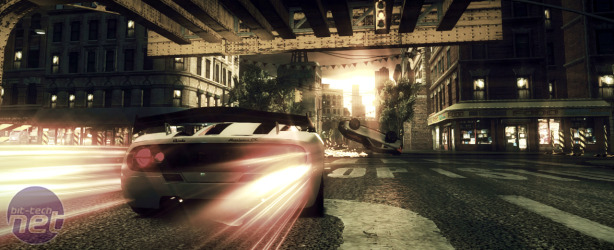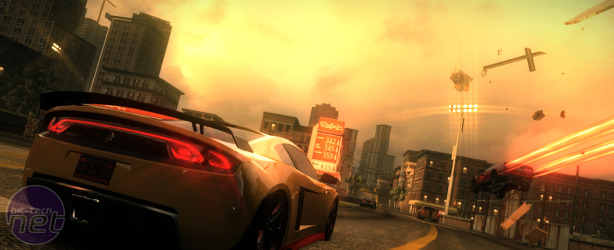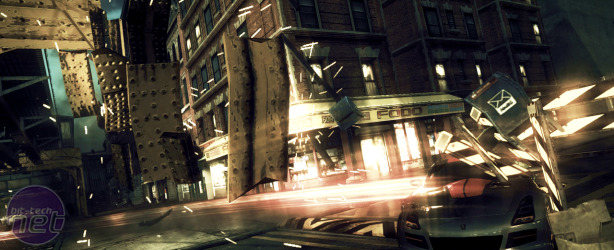
Ridge Racer Unbounded review
Publisher: Namco
UK Price (as reviewed): £34.99
US Price (as reviewed): $52.99
The Ridge Racer series has been left choking on the exhaust fumes of the Burnout and Need For Speed games for the past few years now. In an attempt to inject new fuel into the ageing franchise’s tank, Namco Bandai has passed developing duties to FlatOut creator Bugbear. The result is a comprehensive arcade racer that adds to Ridge Racer’s iconic status instead of relying on it.

With the series’ usual focus on drifting sharing the limelight with Burnout style takedowns (frags) and Split/Second inspired environmental destruction, this new Ridge Racer’s aggressive attitude reveals a desire to break loose from the clean approach of its forebears.
In Ridge Racer Unbounded, slipstreaming, destroying scenery and drifting all contribute to a Power meter that grants a turbo boost once full. Boosting can then be used to plow through destructible walls, cause explosions [thanks to some rather irresponsibly parked fuel tankers] and ‘frag’ opponents.
Gone is the light, airy handling of past Ridge Racers, to be replaced with heavier feeling cars that were initially - for us at least - a nightmare to drift with. One of the loading screen tips simply says, ‘press the drift button to drift.’ After hours of trying out different techniques with inconsistent results we almost gave up and started longing for the old days where the smallest use of the brake while turning initiated a sideways slide so effortless it may as well have been on auto-pilot.
Turns out, what that loading screen tip should have said is, ‘hold the drift button to drift’. We had been using it as a handbrake, when actually the drift button in Ridge Racer has no relation to the pedals in car whatsoever – it’s essentially a magic button, one that makes cornering an absolute joy. Though brake and accelerator still need to be used just right to attain perfection.
We have no idea why Bugbear felt the need to include a drift button and not just rely on the cars' natural understeer and oversteer, but that’s beside point. All you need to know is, hold it and in no time you’ll be skidding sideways round the tightest apexes with only a whisker between your front end and a brick wall.

Single-player takes place in Shatter Bay, a fictional amalgamation of various American cities. The back of the box bangs on about some kind of urban racing gang nonsense, but thankfully there’s little mention of this in the actual game. With no shoehorned in story forcing races to be approached in a specific order, you’re free to conquer the city at your own pace.
Thanks to our initial misunderstanding of the drift button, we spent the first few hours replaying the same tracks over and over, failing miserably to take first pace. Before we attained Zen-like drift control the Power meter took ages to fill up, giving nowhere near enough boost to keep up with the pack. There’s no rewind button and the A1 racers are unforgiving, making victory near impossible after a couple for crashes.
With drifting down pat Unbounded is still not easy, but everything makes a lot more sense. The boost bar fills after most corners and it’s possible to claw back positions and gain first place.
Whether you win or lose, points are still earned depending on how much damage is caused on the way. Higher ranks mean better cars, so if an early race keeps on defeating you, it can be returned to with a more powerful machine that will give you the upper hand.
As well as cars and new challenges, ranking up awards map pieces that can be used in the intuitive track editor. Easy to use – just slot the map pieces together on a grid – the editor provides scope for a lot of potential replay value long after the main game’s tracks have been exhausted. Created tracks are shared online and the creator's high scores can be challenged, giving an incentive to try them.
Time Attacks, Frag Attacks and Drift Attacks add variety to single-player. Time Attacks are time trails with an arcadey twist in the form of time modifiers to collect and insane ramps to navigate. Frag Attacks are all about taking out other racers, while Drift Attacks are about delaying a countdown and scoring points by drifting as much as possible.

They all make use of the Unbounded’s gameplay mechanics in welcome ways, bringing variety to the single-player with out feeling tacked on. The only real weak link is the Frag Attacks, due to a random element that can make you feel cheated out of victory and, in the later stages, some unbelievably angry opponents.
Current lap, points and timings are shown, augmented reality style, on walls and other surfaces around the track, meaning you never have to take your eyes off what’s coming up to know what’s going on. Combined with a varied colour palette, a solid frame rate and the shiny cars and light trails typical to Ridge Racer, Unbounded is a remarkably slick package.
It’ll take a bit of time to see how the online community develops, but even now we don’t feel it’s hyperbolic to say Unbounded does just enough to usurp Burnout Paradise from pole position and be crowned as champion of the current generation of arcade racers.
Publisher: Namco
UK Price (as reviewed): £34.99
US Price (as reviewed): $52.99
The Ridge Racer series has been left choking on the exhaust fumes of the Burnout and Need For Speed games for the past few years now. In an attempt to inject new fuel into the ageing franchise’s tank, Namco Bandai has passed developing duties to FlatOut creator Bugbear. The result is a comprehensive arcade racer that adds to Ridge Racer’s iconic status instead of relying on it.

Speed. And lots of it.
With the series’ usual focus on drifting sharing the limelight with Burnout style takedowns (frags) and Split/Second inspired environmental destruction, this new Ridge Racer’s aggressive attitude reveals a desire to break loose from the clean approach of its forebears.
In Ridge Racer Unbounded, slipstreaming, destroying scenery and drifting all contribute to a Power meter that grants a turbo boost once full. Boosting can then be used to plow through destructible walls, cause explosions [thanks to some rather irresponsibly parked fuel tankers] and ‘frag’ opponents.
Gone is the light, airy handling of past Ridge Racers, to be replaced with heavier feeling cars that were initially - for us at least - a nightmare to drift with. One of the loading screen tips simply says, ‘press the drift button to drift.’ After hours of trying out different techniques with inconsistent results we almost gave up and started longing for the old days where the smallest use of the brake while turning initiated a sideways slide so effortless it may as well have been on auto-pilot.
Turns out, what that loading screen tip should have said is, ‘hold the drift button to drift’. We had been using it as a handbrake, when actually the drift button in Ridge Racer has no relation to the pedals in car whatsoever – it’s essentially a magic button, one that makes cornering an absolute joy. Though brake and accelerator still need to be used just right to attain perfection.
We have no idea why Bugbear felt the need to include a drift button and not just rely on the cars' natural understeer and oversteer, but that’s beside point. All you need to know is, hold it and in no time you’ll be skidding sideways round the tightest apexes with only a whisker between your front end and a brick wall.

This is Shatter Bay. It is pretend.
Single-player takes place in Shatter Bay, a fictional amalgamation of various American cities. The back of the box bangs on about some kind of urban racing gang nonsense, but thankfully there’s little mention of this in the actual game. With no shoehorned in story forcing races to be approached in a specific order, you’re free to conquer the city at your own pace.
Thanks to our initial misunderstanding of the drift button, we spent the first few hours replaying the same tracks over and over, failing miserably to take first pace. Before we attained Zen-like drift control the Power meter took ages to fill up, giving nowhere near enough boost to keep up with the pack. There’s no rewind button and the A1 racers are unforgiving, making victory near impossible after a couple for crashes.
With drifting down pat Unbounded is still not easy, but everything makes a lot more sense. The boost bar fills after most corners and it’s possible to claw back positions and gain first place.
Whether you win or lose, points are still earned depending on how much damage is caused on the way. Higher ranks mean better cars, so if an early race keeps on defeating you, it can be returned to with a more powerful machine that will give you the upper hand.
As well as cars and new challenges, ranking up awards map pieces that can be used in the intuitive track editor. Easy to use – just slot the map pieces together on a grid – the editor provides scope for a lot of potential replay value long after the main game’s tracks have been exhausted. Created tracks are shared online and the creator's high scores can be challenged, giving an incentive to try them.
Time Attacks, Frag Attacks and Drift Attacks add variety to single-player. Time Attacks are time trails with an arcadey twist in the form of time modifiers to collect and insane ramps to navigate. Frag Attacks are all about taking out other racers, while Drift Attacks are about delaying a countdown and scoring points by drifting as much as possible.

Another happy accident.
They all make use of the Unbounded’s gameplay mechanics in welcome ways, bringing variety to the single-player with out feeling tacked on. The only real weak link is the Frag Attacks, due to a random element that can make you feel cheated out of victory and, in the later stages, some unbelievably angry opponents.
Current lap, points and timings are shown, augmented reality style, on walls and other surfaces around the track, meaning you never have to take your eyes off what’s coming up to know what’s going on. Combined with a varied colour palette, a solid frame rate and the shiny cars and light trails typical to Ridge Racer, Unbounded is a remarkably slick package.
It’ll take a bit of time to see how the online community develops, but even now we don’t feel it’s hyperbolic to say Unbounded does just enough to usurp Burnout Paradise from pole position and be crowned as champion of the current generation of arcade racers.
-
Overall85 / 100


MSI MPG Velox 100R Chassis Review
October 14 2021 | 15:04









Want to comment? Please log in.